You
are receiving this because your address is subscribed at: www.jaunay.com/newsletter.html |
|
 |
| No: 94 |
December 2013
|
|
News December seminars No seminars are planned for December. January seminars No seminars are planned for January. See the seminar program for more details and bookings. QueryPic A new search engine for the digitised newspapers in Trove (Australian Newspapers) and Papers Past (New Zealand papers) called QueryPic is now available. Testing out the site I discovered it revealed more items using this site than a search based at the Trove site does! I put a family name Jaunay in the search box, selected Australia and clicked the Show button. A graph appears with the years along the base and the number of articles that match the query are shown on the left. As you run the cursor over the nodes a box appears which tells you how many articles there are for that date. Click to view the article. It is a good way of finding articles and the range of articles. The QueryPic site states that, exploring digitised newspapers from Australia and New Zealand, QueryPic provides a new way of seeing, searching and understanding the digitised newspapers made available by Trove and Papers Past. Follow changes over time. Map trends and patterns. Follow a hunch. Frame a question. Explore. After my initial look at the site I could not agree more! The National Archives As part of the centenary celebrations for the start of World War 1 The National Archives are launching more digitised record series, including the unit war diaries (Series WO 95), from January. These records are selected war diaries of units (not personal diaries) for British and colonial units serving in theatres of operations between 1914 and 1922. National Archives of Australia Sara King, Commonwealth Government Records about South Australia ($19.95) was recently launched by former Premier, John Bannon. This publication lists all, or nearly all, records relating to South Australia, in the National Archives under twenty chapters. When the Commonwealth was created in 1901, the new Commonwealth departments commenced creating their own records, but in the case of South Australia they also inherited records from the colonial government predecessor. For example Post Office material for SA dating back to as early as 1866 is in the collection including material relating to the Overland Telegraph. Data records now at FindMyPast Adelaide Proformat's data records can now be accessed at the FindMyPast site. To commemorate these data sets FindMyPast has written 3 background blogs about the records. |
In
this issue: |
|
Graham Jaunay |
An introduction to heraldry 2 Some scholars suggest that Edward the Confessor, who reigned from 1042 to 1066 had the first coat of arms in England (pictured). It is clear that heraldic symbols existed before this but were not thought to have been used for individuals. The practice developed its complexity with the arrival of the Normans and this is reflected in the fact that the first arms did not appear in Scotland until 1177 when they appear on the Seal of the second High Steward, Allen Fitz Walter Stewart (1126–1204) Some scholars suggest that Edward the Confessor, who reigned from 1042 to 1066 had the first coat of arms in England (pictured). It is clear that heraldic symbols existed before this but were not thought to have been used for individuals. The practice developed its complexity with the arrival of the Normans and this is reflected in the fact that the first arms did not appear in Scotland until 1177 when they appear on the Seal of the second High Steward, Allen Fitz Walter Stewart (1126–1204)As mentioned previously, each coat of arms is defined by a written description known as blazon. French was the international language of the Middle Ages and many of the terms used in heraldry have Old French origins such as azure for blue. Any illustrated depiction of a coat of arms is the result of an heraldic artist's expression of its blazon. Colours and shapes are not defined precisely in heraldry and each artist's work may vary in shape or colour shade. However, the blazon should be sufficiently precise and unique such that, even allowing for artistic variations, each depiction of a coat of arms by any heraldic artist is recognisable as a specific coat of arms.  Some researchers may be interested in reading a Coat of Arms. Some researchers may be interested in reading a Coat of Arms.The main feature in all arms is the shield and how it is decorated. This in itself is quite complex and the following is a very basic outline only and mainly relates to the practice in England: Shape The shape of a shield has no significance except that a daughter always has by courtesy only, unless she is the heir, a diamond version of her father’s arms. Upon marriage, her courtesy shield will be that of her husband’s. Pictured to the right are the arms of Queen Margaret of Scotland (1045-1093). Impalements A shield divided vertically almost always indicates a marriage with the dexter (right from the perspective of the holder) half bearing the husband’s and the sinister (left) the wife’s. This is known as an impalement. Queen Margaret of Scotland's arms above are an example of this process where her husband's arms are on the right being the lion rampant denoting a monarch of Scotland while hers are on the left. 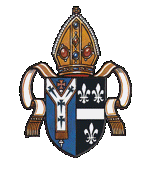 The exception to this rule are the arms of bishops and other holders of official positions whose personal arms may be impaled by their organisation or See. Justin Portal Welby (b. 6 Jan 1956) the 105th and current Archbishop of Canterbury has the Welby arms impaled with the Province of Canterbury (pictured right). Quartering A shield may be divided into four or more divisions each with a coat of arms inherited by marriages to armigerous heiresses. The first quarter always contains the primary surname arms.  Escutcheon of pretence
Escutcheon of pretenceThis refers to a small shield in the centre of the main shield usually indicating the marriage to an heiress as opposed to the marriage to a woman with an armigerous father. Thus with Queen Margaret of Scotland's arms above, her arms were impaled with her husband's simply because she was not an heiress, that is she was not the eldest daughter in a family with no sons. Less commonly the arms of a conqueror or overlord may feature an escutcheon of pretence of the subject country! In the case of William and Mary they indicated their relationship to Nassau using the same device. (Pictured left) Cadency marks  These are small symbols in the centre of the upper part of the shield to denote seniority of sons. This system does not apply in Scotland which applies a system of coloured borders, varied outlines, and so on. In England cadency marks can accommodate up to nine sons. The eldest son's mark is called a label on his father's death he discards the label on the shield while his younger brothers lose the right to the shield altogether! The English cadency marks are depicted to the right: 1: label of three points; 2: crescent; 3: mullet; 4: martlet; 5: annulet; 6: fleur-de-lys; 7: rose; 8: cross moline; 9: octofoil. These are small symbols in the centre of the upper part of the shield to denote seniority of sons. This system does not apply in Scotland which applies a system of coloured borders, varied outlines, and so on. In England cadency marks can accommodate up to nine sons. The eldest son's mark is called a label on his father's death he discards the label on the shield while his younger brothers lose the right to the shield altogether! The English cadency marks are depicted to the right: 1: label of three points; 2: crescent; 3: mullet; 4: martlet; 5: annulet; 6: fleur-de-lys; 7: rose; 8: cross moline; 9: octofoil.Scotland, like England, uses the label of three points for the eldest son and a label of five points for the eldest son of the eldest son, and allows the label to be removed as the bearer of the plain coat dies and the eldest son succeeds. For cadets other than immediate heirs, Scottish cadency uses a complex and versatile system of borders and charges on the shield. 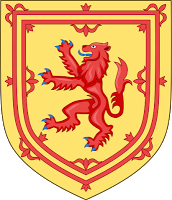 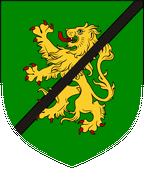  Marks of illegitimacy Such marks are rare and almost only ever seen on arms of natural sons of monarchs and peers where illegitimacy was no bar to being important on a social scale! It can be a diagonal black band or baton or a fancy border. Pictured: Right—King James V son, Robert Stewart, Earl of Orkney. Centre—an illegitimate line within the Morgan family. Left—Henry I son, Reginald Earl of Cornwall. It is important to note that such a depiction does not always signal illegitimacy.  Augmentation Is an addition to the original shield granted in recognition by the monarch of a deed or service. The augmentation added to the Howard arms represents his participation in the battle of Flodden and depicts the Scottish heraldic lion with an arrow piecing the head. The Duke of Wellington was honoured with the British Flag on his shield. The shield is the main part of a coat of arms and can be displayed alone. A Coat of Arms will include the shield and some of the following items many of which were displayed in the coat of arms depicted in the previous newsletter…   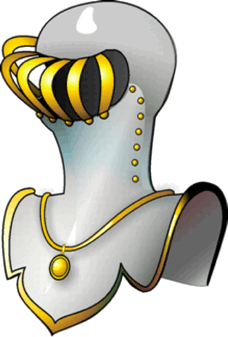  1. Helm—the helmet always sits above the shield and varies according to rank. A helm facing sinister (to the viewer's right) denotes bastardy. L-R: royal, peer, knight, commoner.  
2. Caps, coronets and crowns—may also be included to show rank and are sometimes displayed instead of the helm but often in addition to the helm to also demonstrate rank. Left: Earl's coronet and monarch's crown. 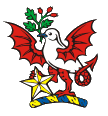     3. Crest—is the device located above the helm. The crest, while not always a unique item, comes in a multitude of forms and can be displayed alone. It can also be displayed by family members not entitled to display the shield. You often see a crest adorning a building. Many people incorrectly call a coat of arms a crest.  4. Wreath or torse—the torse sits upon the helm and always has six twists. Its colours are those of the main colours depicted on the shield. Like all these items the torse was originally part of an armoured knights' apparel. In this case the torse was worn on the head to protect the skull from the helmet. 4. Wreath or torse—the torse sits upon the helm and always has six twists. Its colours are those of the main colours depicted on the shield. Like all these items the torse was originally part of an armoured knights' apparel. In this case the torse was worn on the head to protect the skull from the helmet.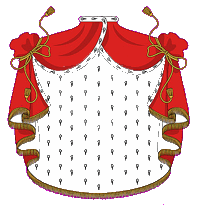 5. Mantling—the drapes flowing from the helm to form the framing of the arms represent the knight’s cloak. They are often very stylised and not recognised as a cloak. 6. Supporters—figures flanking the shield are found only on high ranking individuals’ arms. Like crests they come in a multitude of forms. Australia has a kangaroo and emu as supporters.  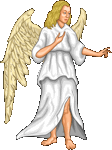 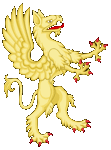  7. compartment—a device sometimes used for the suopporters to stand on. Pictured above is the compartment for the arms of HM The Queen. Note the Tudor or English roses. 8. Motto—mottoes either above or below or both usually in French or Latin are not granted with armorial bearings and may be adopted and changed at will.  All the aspects of a Coat of Arms are collectively called the Achievement and is described in heraldic language called blazon. They are usually arranged as depicted adjacent in the arms of HM The Queen.
All the aspects of a Coat of Arms are collectively called the Achievement and is described in heraldic language called blazon. They are usually arranged as depicted adjacent in the arms of HM The Queen.Heraldry is a very complex subject and the foregoing material has in some cases been simplified for the sake of clarity! While The Queen's achievement is illustrated, the rules applying to heraldry are not strictly followed by the Royal family because their arms are determined by the sovereign. |
|
| To
unsubscribe send a blank email via the following link using the same
address you subscribed to: newsletter-leave@jaunay.com |